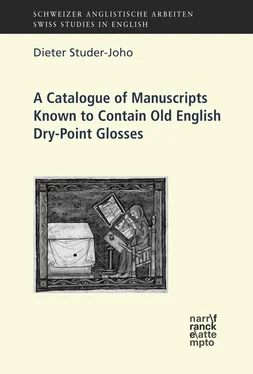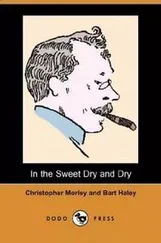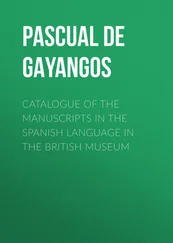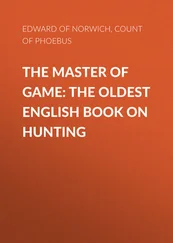Dieter Studer-Joho
A Catalogue of Manuscripts Known to Contain Old English Dry-Point Glosses
Narr Francke Attempto Verlag Tübingen
[bad img format]
© 2017 • Narr Francke Attempto Verlag GmbH + Co. KG
Dischingerweg 5 • D-72070 Tübingen
www.francke.de• info@francke.de
Das Werk einschließlich aller seiner Teile ist urheberrechtlich geschützt. Jede Verwertung außerhalb der engen Grenzen des Urheberrechtsgesetzes ist ohne Zustimmung des Verlages unzulässig und strafbar. Das gilt insbesondere für Vervielfältigungen, Übersetzungen, Mikroverfilmungen und die Einspeicherung und Verarbeitung in elektronischen Systemen.
E-Book-Produktion: pagina GmbH, Tübingen
ePub-ISBN 978-3-7720-0030-0
[bad img format]
To my Parents
Trudi and Sepp
This book would have never seen the light of day, if it had not been for the support and encouragement of a good number of people, and I would like to take the opportunity to express my heartfelt thanks to them.
Andreas Fischer is solely responsible for kindling my enthusiasm for historical linguistics in general and Old English philology in particular. I am profoundly grateful to him for backing my PhD project, even though it was already foreseeable that the office of President of the University would leave him precious little time for dry-point concerns.
I am deeply indebted to Elvira Glaser for being such a great boss to me for so many years. I very much enjoyed the time under her supervision, first as her student assistant (and personal book mule) and later as a research assistant at the Phonogrammarchiv der Universität Zürich . The perfectly nonsymbiotic combination of Swiss German dialectology and Old English dry-point glossography was only rendered possible by her boundless patience and unwavering confidence in my capabilities. Moreover, I am profoundly grateful to her for securing an extension to my assistantship for an additional year, which allowed me to finish my PhD thesis in perfect peace of mind and in financial security, too.
Andreas Nievergelt was an immeasurably important inspiration for my dry-point interests. He gave me advice and moral support on countless occasions. His unbelievable diligence and his knowledgeability have always been a tremendously motivating beacon during the often painfully slow progress of my PhD project.
I also wish to acknowledge the generous financial support of the Swiss National Science Foundation for this publication and I am grateful to the Narr Francke Attempto Verlag and to Andreas Fischer, Martin Heusser and Daniel Schreier, the editors of Schweizerische Anglistische Arbeiten , for givining me the opportunity to publish my work in their series. At the same time I would also like to thank Martin Heusser for his support in designing the title page and I am grateful to the British Library for their permission to reproduce a miniature from their holdings.
I am much obliged to Michael Schwarzenbach, Stephan Schmid and Camilla Bernardasci for being wonderful office colleagues and for making me continuously look forward to my working days at the Archives all those years. Annina and Ludwig Rübekeil Seiler encouraged me to keep up the good work so many times, and Christine Wallis gave me hope that I was not the only person on the planet working in this somewhat dusty corner of English philology.
I would also like to express my deepest gratitude to my family: I am eternally grateful to my parents, Trudi and Sepp Studer-Bänziger, for their unconditional love and wholehearted support through all those many years. Above all, however, I am indebted in uncountable ways to my dear wife and soulmate Nicole Studer-Joholove of my life, whose positive influence on me during our two decades of shared history so far defies any description: I cherish your company beyond measure and I take great pride and joy in sharing parenthood of our beautiful daughters Lisa and Michelle with you.
It was for the mere fact that I had a digital camera that I actually ever got into contact with dry-point glosses. Back in 2006, a colleague of mine – Prof. Dr. Andreas Nievergelt – asked me to accompany him to the Zentralbibliothek Zürich to take some pictures of a MS that contained what he called Griffelglossen . He was making the final changes to his dissertation on the OHG dry-point glosses in a Bavarian MS, which was just about to be published (i.e. Nievergelt 2007), and he wanted to embellish it further with some additional crisp pictures of several OHG dry-point glosses from two MSS of the nearby Zentralbibliothek . My ignorance of dry-point glosses back then was nearly complete. I had heard him and Prof. Dr. Elvira Glaser – for whom I worked as a student assistant at the time – talk about the subject and I had written a term paper in my minor subject German on some OHG ink glosses from St. Gallen. However, I was not even sure whether dry-point glossing was an exclusively Continental practice or whether the phenomenon was known from Anglo-Saxon MSS, too. Needless to say, when we finally stood around the first MS and Andreas pointed the glosses out to me I was fascinated: In a seemingly empty spot of a 9 th-c. MS of ALDHELM’s Carmen de virginitate AldhelmCarmen de virginitate, OHG letters started to appear as soon as the electric torch in his hand hit the MS surface at the right angle.Zürich, ZentralbibliothekMs. C 59Zürich, ZentralbibliothekMs. C 411
Having myself a keen interest in Old English philology, I tried to find out whether the phenomenon was known from Anglo-Saxon studies, too, and I soon had to realize that there was hardly any information available on the subject, apart from general references to the existence of such glosses in passing (e.g. Lendinara 1991: 273). The most detailed piece of information I could gather was printed in Mechthild Gretsch’s handbook entry on “Glosses” in the Blackwell Encyclopaedia of Anglo-Saxon England :
Glosses may be entered in ink or with a stylus; such ‘scratched’ or ‘dry-point’ glosses are often visible under special lighting conditions only, and their original purpose is difficult to define. Many of these scratched glosses have not yet been published; presumably many more still await detection. (Gretsch 1999b: 209)
What I had hoped to find, however, was a list of MSS or at least an estimate of how many MSS there were known to feature dry-point writing. Having been schooled in OHG glossography, with its impressive gloss collections, multivolume handbooks, exhaustive bibliographies and specialized gloss dictionaries, my expectations were admittedly naïve. That kind of information was simply not available in the Anglo-Saxonist literature.
Probably the only common ground shared by virtually all scholars who have commented on or even have edited OE dry-point glosses is the suspicion that there are many more OE dry-point glosses yet to be found.
In the case of [Cambridge, CCC 285Cambridge, Corpus Christi CollegeMS 285[6/K:54]2] I have, I believe, included all these [=dry-point] glosses, but in the case of the other MSS I gave up the attempt: the deciphering of the scratched glosses was so trying to the eyes, moreover it was so frequently impossible to read them with certainty, that I preferred to confine myself to the properly written glosses. (Napier 1900: xxxiii)
[I]t seems not at all unlikely that other manuscripts with large numbers of legible scratched glosses will yet come to attention. (Meritt 1945: viii)
The fact that they [the dry-point glosses in Cambridge, CCC 57Cambridge, Corpus Christi CollegeMS 57[3/K:34]] were not spotted earlier shows how chancy finding such glosses is and how unlikely it is that our corpus of them is anything like complete. (Page 1979: 30)
Читать дальше












